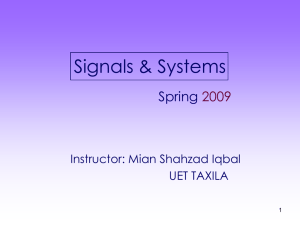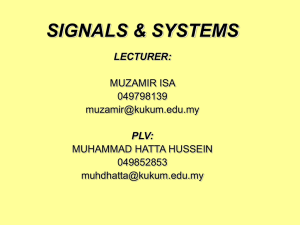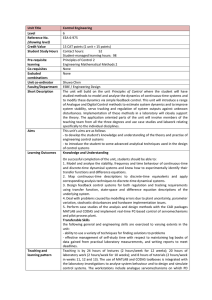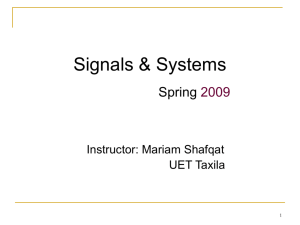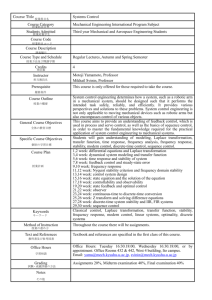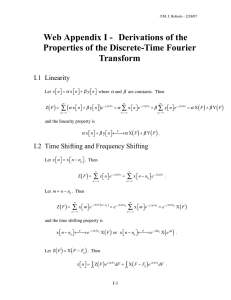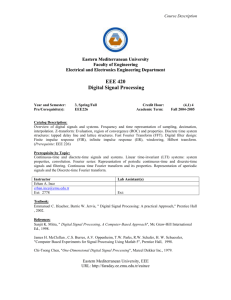z
advertisement
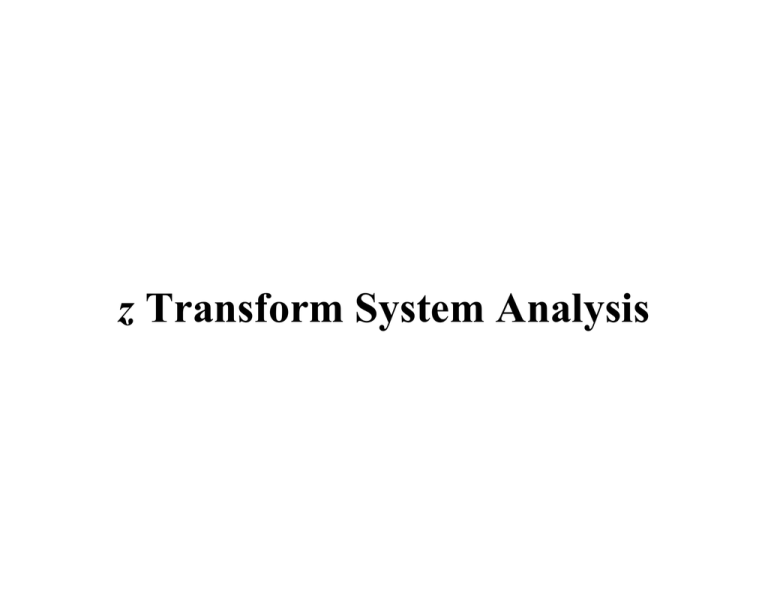
z Transform System Analysis Block Diagrams and Transfer Functions Just as with continuous-time systems, discrete-time systems are conveniently described by block diagrams and transfer functions can be determined from them. For example, from this discretetime system block diagram the difference equation can be determined. y [ n ] = 2 x [ n ] − x [ n − 1] − (1 / 2 ) y [ n − 1] 12/29/10 M. J. Roberts - All Rights Reserved 2 Block Diagrams and Transfer Functions From a z-domain block diagram the transfer function can be determined. Y ( z ) = 2 X ( z ) − z −1 X ( z ) − (1 / 2 ) z −1 Y ( z ) Y( z ) 2 − z −1 2z − 1 H (z) = = = −1 X ( z ) 1 + (1 / 2 ) z z +1/ 2 12/29/10 M. J. Roberts - All Rights Reserved 3 System Stability A system is stable if its impulse response is absolutely summable. That requirement translates into the z-domain requirement that all the poles of the transfer function must lie in the open interior of the unit circle. 12/29/10 M. J. Roberts - All Rights Reserved 4 System Interconnections Cascade Parallel 12/29/10 M. J. Roberts - All Rights Reserved 5 System Interconnections Feedback Y( z ) H1 ( z ) H1 ( z ) H (z) = = = X ( z ) 1 + H1 ( z ) H 2 ( z ) 1 + T ( z ) T ( z ) = H1 ( z ) H 2 ( z ) 12/29/10 M. J. Roberts - All Rights Reserved 6 Responses to Standard Signals N (z) If the system transfer function is H ( z ) = the z transform D(z) z N (z) of the unit-sequence response is H −1 ( z ) = which z − 1 D(z) can be written in partial-fraction form as N1 ( z ) z Y( z ) = z + H (1) D(z) z −1 N1 ( z ) If the system is stable the transient term z dies out D(z) z and the forced response is H (1) . z −1 12/29/10 M. J. Roberts - All Rights Reserved 7 Responses to Standard Signals Kz Let the system transfer function be H ( z ) = . z− p z Kz K ⎛ z pz ⎞ Then Y ( z ) = − − ⎜ z − 1 z − p 1 − p ⎝ z − 1 z − p ⎟⎠ ( ) K and y [ n ] = 1 − p n+1 u [ n ]. 1− p ( ) Let the constant K be 1 − p. Then y [ n ] = 1 − p n+1 u [ n ]. 12/29/10 M. J. Roberts - All Rights Reserved 8 Responses to Standard Signals Unit Sequence Response One-Pole System 12/29/10 M. J. Roberts - All Rights Reserved 9 Responses to Standard Signals Unit Sequence Response Two-Pole System 12/29/10 M. J. Roberts - All Rights Reserved 10 Responses to Standard Signals N (z) If the system transfer function is H ( z ) = the z transform D(z) of the response to a cosine applied at time n = 0 is N ( z ) z ⎡⎣ z − cos ( Ω0 ) ⎤⎦ Y( z ) = D ( z ) z 2 − 2z cos ( Ω0 ) + 1 Let p1 = e jΩ0 . Then the system response can be written as ⎛ N1 ( z ) ⎞ y[n] = Z ⎜ z + H ( p1 ) cos Ω0 n + ∠ H ( p1 ) u [ n ] ⎟ ⎝ D(z) ⎠ ( −1 ) and, if the system is stable, the forced response is ( ) H ( p1 ) cos Ω0 n + H ( p1 ) u [ n ] a sinusoid with, generally, different magnitude and phase. 12/29/10 M. J. Roberts - All Rights Reserved 11 z Transform - Laplace Transform Relationships Let a signal x(t) be sampled to form x [ n ] = x ( nTs ) and impulse sampled to form xδ ( t ) = x ( t )δ Ts ( t ) These two signals are equivalent in the sense that their impulse strengths are the same at corresponding times and the correspondence between times is t = nTs . 12/29/10 M. J. Roberts - All Rights Reserved 12 z Transform - Laplace Transform Relationships Let a discrete-time system have the impulse response h [ n ] and let a continuous-time system have the impulse response If x [ n ] is applied to the discrete-time system and hδ ( t ) = ∑ n=0 h [ n ]δ ( t − nTs ) . ∞ xδ ( t ) is applied to the continuous-time system, their responses will be equivalent in the sense that the impulse strengths are the same. 12/29/10 M. J. Roberts - All Rights Reserved 13 z Transform - Laplace Transform Relationships The transfer function of the discrete-time system is ∞ H ( z) = ∑ h[n] z−n n=0 and the transfer function of the continuous-time system is ∞ Hδ ( s ) = ∑ h [ n ] e− nTs s n=0 The equivalence between them can be seen in the transformation Hδ ( s ) = H ( z ) z→esTs 12/29/10 M. J. Roberts - All Rights Reserved 14 z Transform - Laplace Transform Relationships The relationship z = e sTs maps points in the s plane into corresponding points in the z plane. Different contours in the s plane map into the same contour in the z plane. 12/29/10 M. J. Roberts - All Rights Reserved 15 z Transform - Laplace Transform Relationships 12/29/10 M. J. Roberts - All Rights Reserved 16 Simulating Continuous-Time Systems with Discrete-time Systems The ideal simulation of a continuous-time system by a discrete-time system would have the discrete-time system’s excitation and response be samples from the continuous-time system’s excitation and response. But that design goal is never achieved exactly in real systems at finite sampling rates. 12/29/10 M. J. Roberts - All Rights Reserved 17 Simulating continuous-time Systems with discrete-time Systems One approach to simulation is to make the impulse response of the discrete-time system be a sampled version of the impulse response of the continuous-time system. h [ n ] = h ( nTs ) With this choice, the response of the discrete-time system to a discretetime unit impulse consists of samples of the response of the continuoustime system to a continuous-time unit impulse. This technique is called impulse - invariant design. 12/29/10 M. J. Roberts - All Rights Reserved 18 Simulating continuous-time Systems with discrete-time Systems When h [ n ] = h ( nTs ) the impulse response of the discrete-time system is a sampled version of the impulse response of the continuous-time system but the unit discrete-time impulse is not a sampled version of the unit continuous-time impulse. A continuous-time impulse cannot be sampled. First, as a practical matter the probability of taking a sample at exactly the time of occurrence of the impulse is zero. Second, even if the impulse were sampled at its time of occurrence what would the sample value be? The functional value of the impulse is not defined at its time of occurrence because the impulse is not an ordinary function. 12/29/10 M. J. Roberts - All Rights Reserved 19 Simulating continuous-time Systems with discrete-time Systems In impulse-invariant design, even though the impulse response is a sampled version of the continuous-time system’s impulse response that does not mean that the response to samples from any arbitrary excitation will be a sampled version of the continuous-time system’s response to that excitation. All design methods for simulating continuous-time systems with discrete-time systems are approximations and whether or not the approximation is a good one depends on the design goals. 12/29/10 M. J. Roberts - All Rights Reserved 20 Sampled-Data Systems Real simulations of continuous-time systems by discrete-time systems usually sample the excitation with an ADC, process the samples and then produce a continuous-time signal with a DAC. 12/29/10 M. J. Roberts - All Rights Reserved 21 Sampled-Data Systems An ADC simply samples a signal and produces numbers. A common way of modeling the action of a DAC is to imagine the discrete-time impulses in the discrete-time signal which drive the DAC are instead continuous-time impulses of the same strength and that the DAC has the impulse response of a zero-order hold. 12/29/10 M. J. Roberts - All Rights Reserved 22 Sampled-Data Systems The desired equivalence between a continuous-time and a discrete-time system is illustrated below. The design goal is to make y d ( t ) look as much like y c ( t ) as possible by choosing h [ n ] appropriately. 12/29/10 M. J. Roberts - All Rights Reserved 23 Sampled-Data Systems Consider the response of the continuous-time system not to the actual signal x(t) but rather to an impulse-sampled version of it xδ ( t ) = ∞ ∑ x ( nT )δ (t − nT ) = x (t )δ (t ) s s Ts n=−∞ The response is y ( t ) = h ( t ) ∗ xδ ( t ) = h ( t ) ∗ ∞ ∞ ∑ x [ m ]δ (t − mT ) = ∑ x [ m ] h (t − mT ) s m=−∞ s m=−∞ where x [ n ] = x ( nTs ) and the response a the nth multiple of Ts is y ( nTs ) = ∞ ∑ x [ m ] h (( n − m ) T ) . s m=−∞ The response of a discrete-time system with h [ n ] = h ( nTs ) to the excitation x [ n ] = x ( nTs ) is y [ n ] = x [ n ] ∗ h [ n ] = ∞ ∑ x[ m]h[n − m] . m=−∞ 12/29/10 M. J. Roberts - All Rights Reserved 24 Sampled-Data Systems The two responses are equivalent in the sense that the values at corresponding discrete-time and continuous-time times are the same. 12/29/10 M. J. Roberts - All Rights Reserved 25 Sampled-Data Systems Modify the continuous-time system to reflect the last analysis. Then multiply the impulse responses of both systems by Ts 12/29/10 M. J. Roberts - All Rights Reserved 26 Sampled-Data Systems In the modified continuous-time system ∞ ⎡ ∞ ⎤ y ( t ) = xδ ( t ) ∗Ts h ( t ) = ⎢ ∑ x ( nTs )δ ( t − nTs ) ⎥ ∗ h ( t ) Ts = ∑ x ( nTs ) h ( t − nTs ) Ts ⎣ n=−∞ ⎦ n=−∞ In the modified discrete-time system y[n] = ∞ ∞ ∑ x [ m ] h [ n − m ] = ∑ x [ m ] T h (( n − m ) T ) s m=−∞ s m=−∞ where h [ n ] = Ts h ( nTs ) and h ( t ) still represents the impulse response of the original continuous-time system. Now let Ts approach zero. lim y ( t ) = lim Ts →0 Ts →0 ∞ ∑ x ( nT ) h (t − nT )T s n=−∞ s s ∞ = ∫ x (τ ) h (t − τ ) dτ −∞ This is the response y c ( t ) of the original continuous-time system. 12/29/10 M. J. Roberts - All Rights Reserved 27 Sampled-Data Systems Summarizing, if the impulse response of the discrete-time system is chosen to be Ts h ( nTs ) then, in the limit as the sampling rate approaches infinity, the response of the discrete-time system is exactly the same as the response of the continuous-time system. Of course the sampling rate can never be infinite in practice. Therefore this design is an approximation which gets better as the sampling rate is increased. 12/29/10 M. J. Roberts - All Rights Reserved 28 Sampled-Data Systems A continuous-time system is characterized by the transfer function 1 Hs s = 2 . s + 40s + 300 Design a discrete-time system to approximate this continuous-time system. Use two different sampling rates f s = 10 and f s = 100 and () compare step responses. The impulse response of the continuous-time system is 1 −10t h t = e − e−30t u t . 20 () 12/29/10 ( M. J. Roberts - All Rights Reserved ) () 29 Sampled-Data Systems The discrete-time impulse response is Ts −10nTs −30nTs h ⎡⎣ n ⎤⎦ = e −e u ⎡⎣ n ⎤⎦ 20 and the transfer function is its z transform ( ) Ts ⎛ ⎞ z z Hz z = ⎜ − −10Ts −30T 20 ⎝ z − e z − e s ⎟⎠ () The step response of the continuous-time system is 2 − 3e−10t + e−30t yc t = u t 600 and the response of the discrete-time system to a unit sequence is () () ⎤ −10T −30T −10T −30T Ts ⎡⎢ e s −e s e s −10nTs e s −30nTs ⎥ y ⎡⎣ n ⎤⎦ = + −10T e − −30T e u ⎡⎣ n ⎤⎦ −10Ts −30Ts s s ⎥ 20 ⎢ 1− e e −1 e −1 1− e ⎣ ⎦ ( 12/29/10 )( ) M. J. Roberts - All Rights Reserved 30 Sampled-Data Systems The response of the DAC is ⎛ t − Ts ( n + 1 / 2 ) ⎞ y d ( t ) = ∑ y [ n ] rect ⎜ . ⎟ T ⎝ ⎠ ∞ n=0 12/29/10 M. J. Roberts - All Rights Reserved s 31 Standard Realizations • Realization of a discrete-time system closely parallels the realization of a continuous-time system • The basic forms, Direct Form II, cascade and parallel have the same structure • A continuous-time system can be realized with integrators, summing junctions and multipliers • A discrete-time system can be realized with delays, summing junctions and multipliers 12/29/10 M. J. Roberts - All Rights Reserved 32 Standard Realizations Direct Form II 12/29/10 M. J. Roberts - All Rights Reserved 33 Standard Realizations Cascade 12/29/10 M. J. Roberts - All Rights Reserved 34 Standard Realizations Parallel 12/29/10 M. J. Roberts - All Rights Reserved 35
